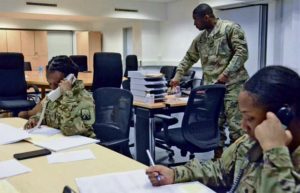There’s no corkboard riddled with pins connecting multi-colored threads in criss-cross fashion in a depiction of intersecting touch points to identify common connections.
This is the military.
It’s slides and spreadsheets.
And phone calls. Lots of phone calls.

“The team mostly makes calls,” explained Dr. Robert Weien, the garrison’s assigned public health emergency officer, “and it can be up to a hundred a day, at the current volume of workload.”
That team, of which Weien is the lead, is Team Trace – one of several garrison-managed groups and task forces stood up to help the garrison community respond effectively to the local implications of the coronavirus disease 2019 pandemic.
After a case of COVID-19 is diagnosed, members of Team Trace identify who that individual may have had close contact within the 48 hours prior to onset of symptoms. The team then makes telephone contact with all identified individuals and makes a determination as to the degree of contact. If determined to be a “close contact,” they then recommend that person go into quarantine.
“They also give instructions to go into isolation (when warranted), and explain what that means,” said Weien, whose “day job” is chief of Occupational Health/deputy chief of Preventive Medicine at Landstuhl Regional Medical Center.
“For both the primary case, and the contacts, the team calls them every day to follow up on their status and the team also keeps extensive records of their calls and results,” he added, citing the importance of the team’s role in “isolating the case of COVID-19 and quarantining the close contacts to interrupt the human-to-human transmission of the virus, and slow or stop the spread of the infection.”
Team Trace actually consists of two teams of at least 10 Soldiers, who are trained for the task after selection, as well as people who have volunteered to supplement the team.
“When we heard Team Trace was in need of volunteers, we put a message out to our workforce and got a great response,” said Gary Burton, the garrison’s director of Family and Morale, Welfare and Recreation. “We have nine FMWR professionals who answered the call and already completed the training needed to join the team. We also have a number of back-up volunteers. We are prepared if called and FMWR is always looking for ways to help.”
An integral part of the team also comes from the garrison’s Directorate of Emergency Services in the form of law enforcement support with military police investigators.
“Detection is key to getting ahead of this,” said Lt. Col. Vic Baez-An, who is tasked with COVID-19 support after turning over the DES leadership recently to Maj. Chase Crabtree. “We have to know who is possibly symptomatic, then we have to identify those who may have come into contact with them. Through early and rapid identification we slow the spread with the hope to eventually close the loop before it even opens.”
“We’re working to decrease the number of cases by having less people out there possibly spreading this,” said Sgt. Colony Hall, team member from the 1st Inland Cargo Transfer Company. “It’s all about ensuring the safety of the force.”
“People may feel that while the numbers seem low, this is due to overabundance of caution that we are implementing,” added Baez-An. “If anyone shows the slightest sign of symptoms they are asked to quarantine immediately. By everyone taking this seriously and being as forthcoming as possible at the gates with Team Screen and in follow up with Team Trace we can get ahead of this.”
Weien also summarized the importance of the team to the community.
“Contact teams like this are the unsung heroes of epidemiology,” he said. “They gather the data that reveals patterns and connections. This enables the processes that move people into isolation and quarantine, and thus prevents transmission of the virus. They can make the difference between watching an epidemic go out of control, and actually flattening the curve.”


